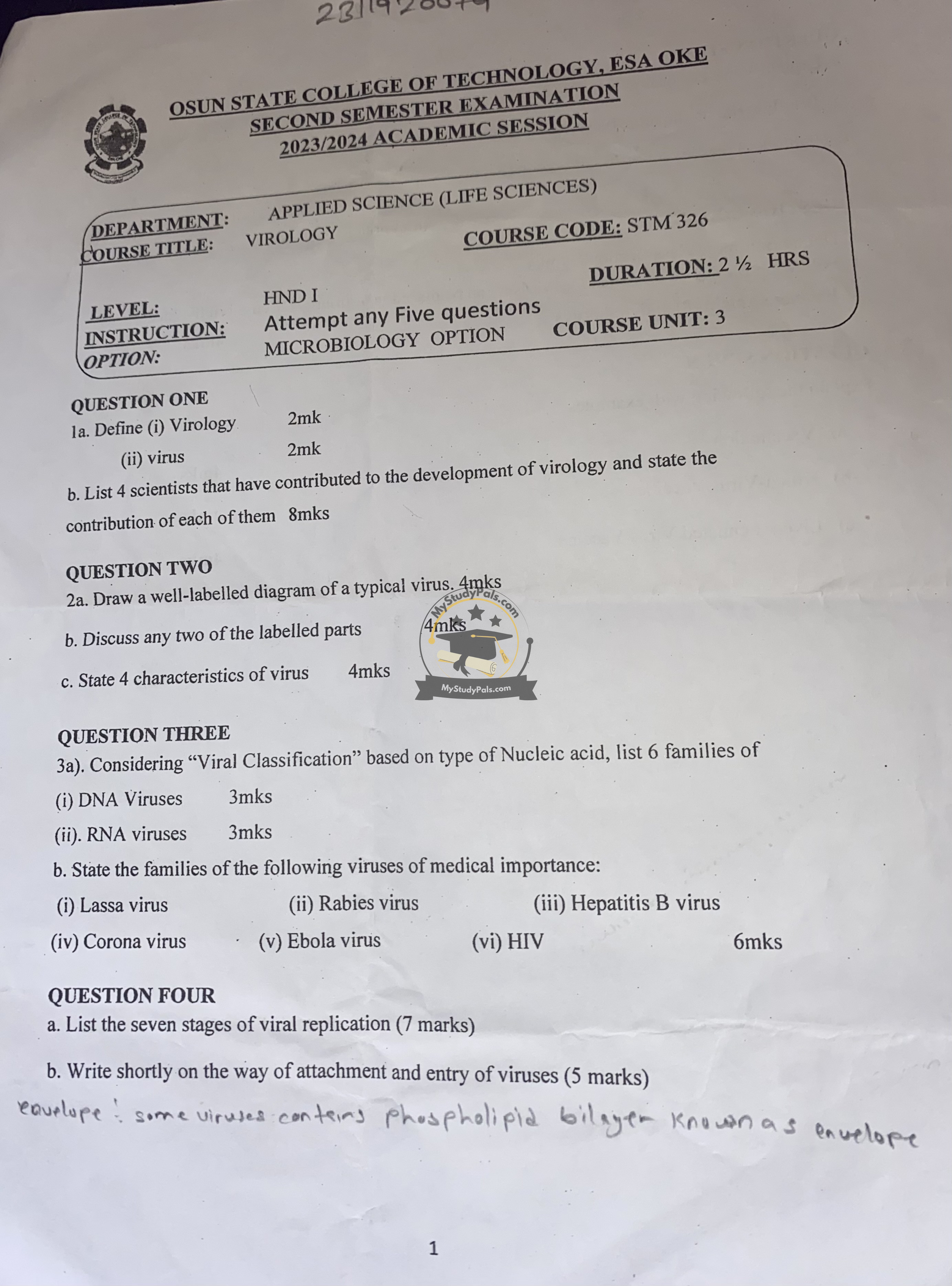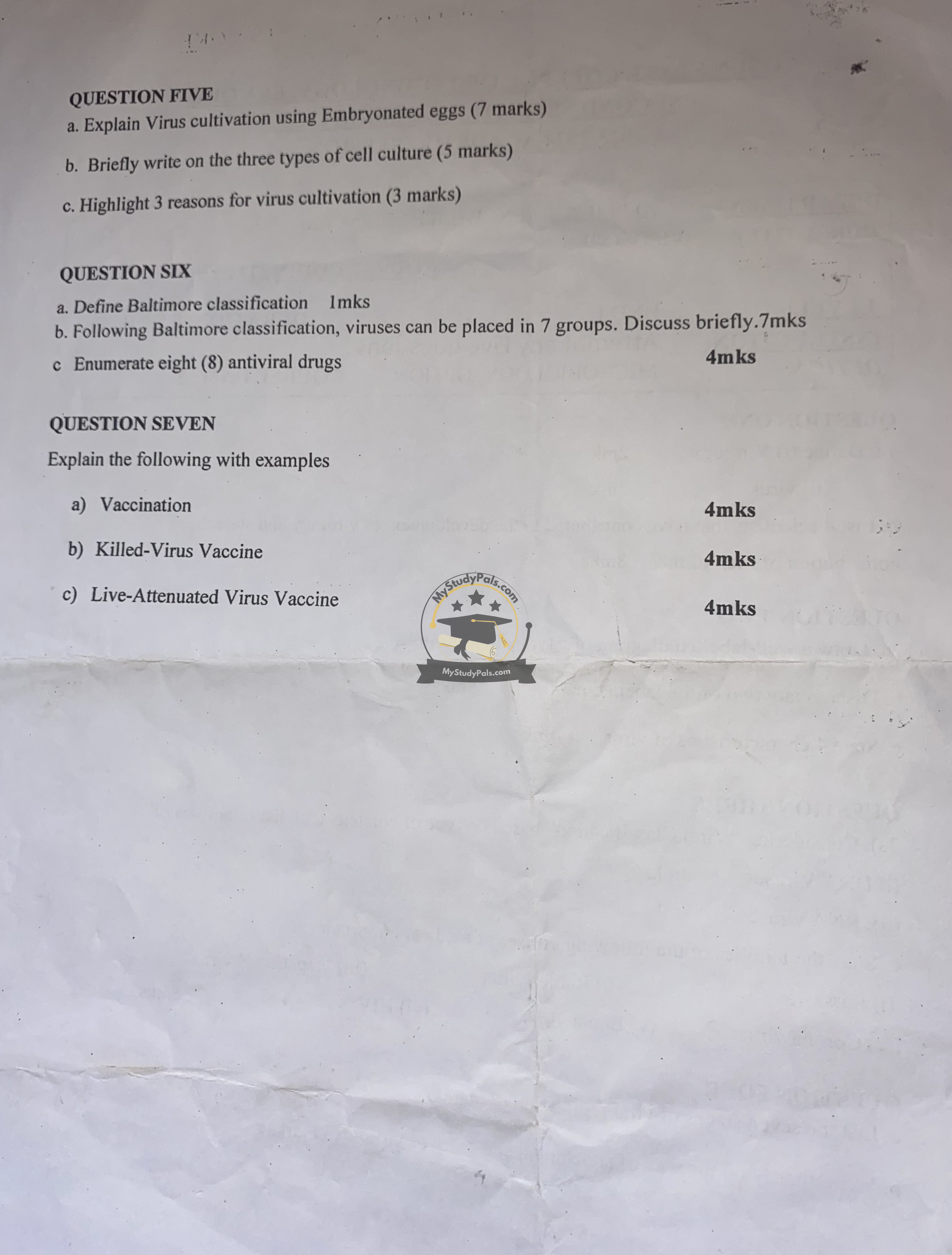ANWSER
—
Question One:
1a.
(i) Virology: The scientific study of viruses, including their structure, classification, replication, and interaction with host organisms. (2 marks)
(ii) Virus: A submicroscopic infectious agent that replicates only inside the living cells of an organism, consisting of genetic material (DNA or RNA) enclosed in a protein coat. (2 marks)
1b. Four scientists and their contributions:
1. Dmitri Ivanovsky – Discovered viruses while studying tobacco mosaic disease (1892).
2. Martinus Beijerinck – Coined the term “virus” and confirmed their non-bacterial nature.
3. Wendell Stanley – Crystallized the tobacco mosaic virus, proving viruses are non-living outside hosts.
4. Jonas Salk – Developed the first effective polio vaccine. (8 marks)
—
Question Two:
2a. A well-labelled diagram of a typical virus should include:
– Capsid (protein coat)
– Nucleic acid (DNA/RNA)
– Envelope (lipid membrane, if present)
– Spike proteins (if applicable)
(4 marks)
2b. Discussion of two labelled parts:
1. Capsid: Protects the viral genome and aids in host cell attachment.
2. Nucleic acid: Contains genetic material (DNA or RNA) for viral replication. (4 marks)
2c. Four characteristics of viruses:
1. Obligate intracellular parasites.
2. Lack cellular structure (no organelles).
3. Contain either DNA or RNA, not both.
4. Reproduce only in host cells. (4 marks)
—
Question Three:
3a. Viral classification by nucleic acid:
(i) DNA Viruses:
– Herpesviridae
– Adenoviridae
– Poxviridae
– Papillomaviridae
– Parvoviridae
– Hepadnaviridae (3 marks)
(ii) RNA Viruses:
– Picornaviridae
– Flaviviridae
– Retroviridae
– Orthomyxoviridae
– Paramyxoviridae
– Rhabdoviridae (3 marks)
3b. Families of medically important viruses:
(i) Lassa virus – Arenaviridae
(ii) Rabies virus – Rhabdoviridae
(iii) Hepatitis B virus – Hepadnaviridae
(iv) Coronavirus – Coronaviridae
(v) Ebola virus – Filoviridae
(vi) HIV – Retroviridae (6 marks)
—
Question Four:
4a. Seven stages of viral replication:
1. Attachment
2. Penetration
3. Uncoating
4. Replication
5. Assembly
6. Maturation
7. Release (7 marks)
4b. Attachment and entry of viruses:
– Viruses attach to host cell receptors via spike proteins.
– Entry methods include:
– Direct fusion (enveloped viruses).
– Endocytosis (non-enveloped viruses). (5 marks)
—
Question Five:
5a. Virus cultivation in embryonated eggs:
– Eggs provide a sterile, nutrient-rich environment.
– Viral inoculation sites: chorioallantoic membrane (CAM), allantoic cavity, or yolk sac.
– Used for vaccines (e.g., influenza). (7 marks)
5b. Three types of cell culture:
1. Primary cultures – Directly from tissues (short-lived).
2. Diploid cell lines – Semi-permanent (e.g., human fibroblasts).
3. Continuous cell lines – Immortalized (e.g., HeLa cells). (5 marks)
5c. Reasons for virus cultivation:
1. Vaccine production.
2. Research on viral pathogenesis.
3. Diagnostic testing. (3 marks)
—
Question Six:
6a. Baltimore classification: A system categorizing viruses based on their genome type (DNA/RNA) and replication strategy. (1 mark)
6b. Seven Baltimore groups:
1. dsDNA viruses (e.g., Herpesvirus).
2. ssDNA viruses (e.g., Parvovirus).
3. dsRNA viruses (e.g., Rotavirus).
4. (+)ssRNA viruses (e.g., Poliovirus).
5. (−)ssRNA viruses (e.g., Influenza).
6. RNA reverse transcribing viruses (e.g., HIV).
7. DNA reverse transcribing viruses (e.g., HBV). (7 marks)
6c. Eight antiviral drugs:
1. Acyclovir
2. Oseltamivir
3. Ribavirin
4. Zidovudine (AZT)
5. Remdesivir
6. Ganciclovir
7. Interferon-alpha
8. Tenofovir (4 marks)
—
Question Seven:
7a. Vaccination: Administration of a vaccine to stimulate immunity against a pathogen (e.g., MMR vaccine). (4 marks)
7b. Killed-Virus Vaccine: Contains inactivated viruses (e.g., Salk polio vaccine). Safe but may require boosters. (4 marks)
7c. Live-Attenuated Vaccine: Uses weakened live viruses (e.g., Sabin polio vaccine). Induces strong, long-lasting immunity. (4 marks)
—



